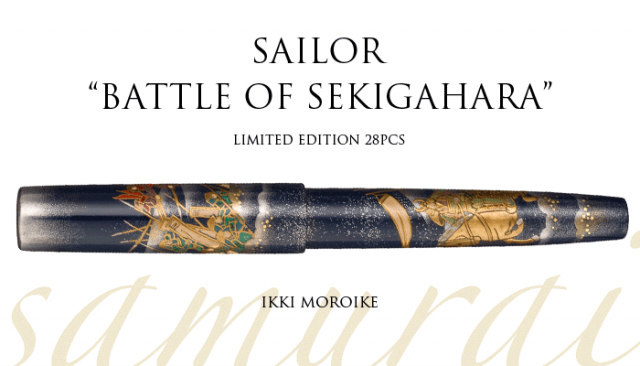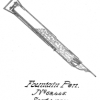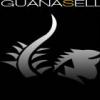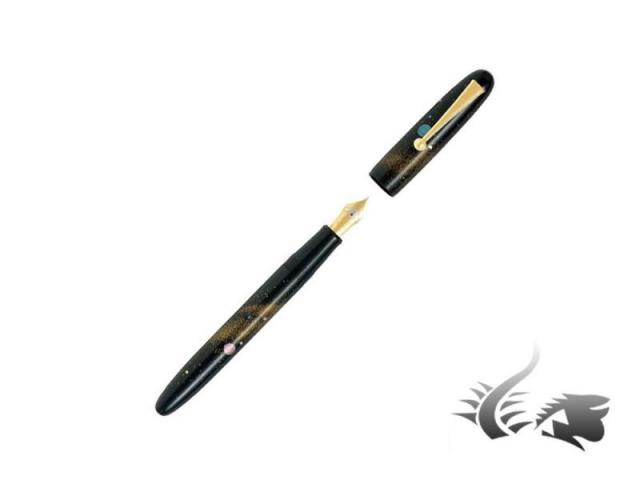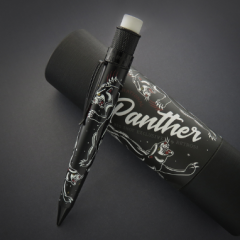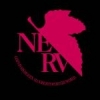Search the Community
Showing results for tags 'makie'.
-
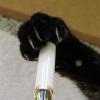
Danitrio seems to have duplicated LE numbers of the same pen in separate “LE” runs
jandrese posted a topic in Japan - Asia
This has been a hot topic on the FPN facebook group but for those not part of that here goes. This is the Danitrio F-49 Blue Dragon on Hyotan LE by the artist Yuji. It is, or was, an LE of 30 pens. Mine is #30. I bought mine in 2018 and it was not a new model then. Pen Venture recently posted a YouTube video of an exactly identical pen with the same LE number by the same artist. No changes at all that I can see. The vendor confirmed to me a second edition of the same pen design was run at some point recently due to popularity. This totally undermines the concept of an LE and devalues every pen made in both (only two?) runs. Pretty much dishonest too. What do y'all think? Untitled-1 yes logo by Ja Ja, on Flickr -
Namiki Emperor Shijin Limited Edition 2020. We expect this limited edition in October! The "Shijin", traditional figures in Chinese mythology, are represented by four sacred animals, guardians of the four cardinal directions in Feng Shui art. Each "Shijin" is associated with a symbolic color and an element that makes up the natural world : wood, metal, fire, and water. Contact catherine@sakuragallery.com https://www.sakurafountainpengallery.com/en/boutique/detail/new-namiki-emperor-shijin-limited-edition-2020-namiki-2 Seiryu and wood: A powerful dragon with the hooves of a deer and the body of a snake represented by a bright blue-green color. It protects the East, controls the element of wood and symbolizes wealth. Byakko and metal: A spiritual tiger who has survived 500 years, represented by shades of brilliant white. He protects the West, governs metal and symbolizes fertility. Susaku and fire: A magnificent phoenix, guardian of the South. Associated with shades of flaming red, it wields the element of fire and symbolizes beauty and intelligence. Genbu and water: A turtle, eternally intertwined with a snake, it promotes human relations. Associated with shades of deep black, it is the guardian of the North, the mistress of the water and symbolizes longevity. Contact catherine@sakuragallery.com
-
Sailor Limited edition Samurai "The Battle of Sekigahara" 21 October 1600. A foggy morning. The Western army lead by Mitsunara Ishida is waiting at the left side of the riverbank. The Eastern army stationed at the right side of the river is lead by Warlord Tokugawa Leyasu. Shogun Lords gathered their armies at either side of the river. Some of them deceivingly undecided about which side to choose. Others will change camps in the heath of the battle. About 200 000 warriors are ready to fight the Battle of Sekigahara. Half of them will be perished by the end of the day. The Battle of Sekigahara was probably the most famous decisive Samurai battle that led to the establishment of the Tokugawa shogunate. Sailor commissioned Ikki Moroike to create a limited edition pen "The Battle of Sekigahara" in high-end Maki-e to commemorate this important historical event. He made 28 fountain pens in Togidashi Taka-maki-e with sublime techniques. Each pen is offered in a lacquered box with Maki-e design on the lid. We can offer #3/28. Please contact us. https://www.sakurafountainpengallery.com/en/boutique/detail/samourai-battle-of-sekigahara-sailor-limited-edition
-
Namiki Emperor Limited Edition 2019 SHOKI. Expected in October but already in stock! In the Edo period, a man appeared to be a brilliant physician, but the Emperor revoked him due to his ugly appearance: long beard with a mustache, big white eyes in a scowling face, dressed in odd clothes. The physician, shocked and embarrassed, killed himself and was sent to the underworld. Since he had skills and potential, he received the task to hunt and scare away evil spirits. Since then, Shoki has been revered as the god who protects from evil spirits and sickness. https://www.sakurafountainpengallery.com/en/boutique/detail/namiki-emperor-shoki-limited-edition-2019-namiki There is no doubt that this pen is made using high-end techniques in Shishiai Togidashi Taka Maki-e. The pen comes in a dark green lacquered box with an inkpot. It is limited to 99 copies worldwide and signed by artist Yutaka Sato. If you are interested in this magnificent work of art please contact us we only have one! Enjoy your week! Catherine
-

Namiki Mandarin Duck Ode To Love. Last Pen For Europe !
Sakura FP Gallery posted a topic in The Mall
The Namiki Emperor Mandarin Duck is an ode to love. It is adorned with a couple of Mandarin Ducks lovingly and peacefully swimming on a pond bordered with reeds and flowers, in a decor of colorful maple leaves. Mandarin Ducks are the only duck species that mate for life. Once they find a partner, they remain a couple until their death. If one dies, the other one often disappears soon after. In Asia, they are a symbol of love, fidelity, and marital happiness. In Japan, they are a lucky charm and often gifted as a wedding present. Namiki released The Emperor Mandarin Duck in 2007. It is kept a secret how many pieces are made since then. Namiki decided to end the theme with the mandarin ducks. This Namiki Emperor Mandarin Duck is the very last in Europe. This is the last chance to buy this beautiful Mandarin Duck! Check out the website for more pictures. In real life, it is even more stunning. https://www.sakurafountainpengallery.com/en/boutique/detail/madarin-duck-oshidori-namiki-emperor-collection- 6 replies
-
- namiki
- mandarinduck
-
(and 2 more)
Tagged with:
-
The 100th anniversary of the Namiki group is cause for a special celebration. Seven artisans from the present Kokkokai group contributed to the creation of seven Yukari-type fountain pens. They are all equipped with a clip and an 18-karat gold nib. Each model is made in Taka Maki-e and shows one of The Seven Gods of Fortune. Only 25 of 150 of each pen are available in Europe. Please contact us for available numbers. https://www.sakurafountainpengallery.com/en/boutique/namiki-japanse-pennen Sincerely, Catherine
- 2 replies
-
- namiki
- sevengoodsofgoodfortune
-
(and 2 more)
Tagged with:
-
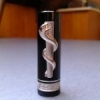
Platinum Izumo Yagunomuri Ginsen. A Serene Giant Pen.
columela posted a topic in Fountain Pen Reviews
B]First Impressions[/b] (10/10) This is a pen that I have secretly desired for more than a year, since I read some reviews of it with the gorgeous pictures! However it was clearly outside my price range. Fortunately a well known US online retailer put some of these pens for sale at half price earlier this year so I jumped at the opportunity. This is my first true Maki-e pen, as I have another smaller and cheaper Platinum Kanazawa Haku which is mass produced using what is more or less a print maki-e design. One of the incarnations of the Platinum Izumo line. The Ginsen Yakunomuri is one of the 4 designs based in the motif of “sea of clouds” from the shinto Shrine in Izumo province, home of the founder of the Platinum pen company. The pen comes in a nice bamboo box, with a cartridge and a converter, and also a very nice silk pen pouch, wich also has the cloud motif in the band. http://i.imgur.com/9KZ5vdv.jpg http://i.imgur.com/p8mkLIK.jpg http://i.imgur.com/S60bD6E.jpg Appearance (10/10) The serene beauty of this pen comes from the original curved shape, the brilliant gloss of the urushi lacquer and the beautifully crafted and hand painted clouds in green, red and mainly brown, all sparkling with the gold and silver particles that make the pen a truly work of art. My model is the Ginsen or silver wire. The clouds are outlined in a subtle line of silver. I can spend hours looking at the sparkle of gold and silver dust over the clouds. http://i.imgur.com/oAPASPo.jpg http://i.imgur.com/bmpljmo.jpg http://i.imgur.com/VyxoJ0a.jpg http://i.imgur.com/fGQ7TIY.jpg Design/Size/Weight (9/10) The pen is shaped in a very original design, which is a variation of the typical cigar but with noticeable curves in the body and cap of the pen. The size of the pen is huge. You can see here comparisons with other pens in my collection ( Parker Duofold, Platinum President, Pilot Custom 823 and Montblanc 149) which are dwarfed by the legth and width of this beauty. http://i.imgur.com/FnJAeS6.jpg http://i.imgur.com/xuED5LR.jpg Weight 34.7 g Length closed 157 mm Length of the barrel 137 mm On the hand is a very comfortable pen, which is surprising given the size of it. It cannot be securely posted, which is probably a good thing so the delicate maki-e design does not suffer with the constant scratch of the pen and cap. Nib (8/10) The pen has a standard 18 k gold Platinum President nib. As I had a President pen of near perfect performance, I was not sad, but it is too big of a pen to have a nib of this size. In my opinion , this is the only disappointing feature of this model. The nib in itself works really well, although my M nib works really like a thin EF, which is good for my style of writing but it might annoy others. http://i.imgur.com/Ua6kFBy.jpg Filling System (8/10) The usual cartridge-converter system which Platinum uses is also present in this pen. There is nothing special to it, but again it is surprising to have such a large pen with a small ink capacity. http://i.imgur.com/nOAfwiY.jpg Cost and Value (9/10) I got the pen for about 2/3 of the cheapest retail cost that I had seen in different online retailers, including the japanese ones. I find it one of the jewels of my collection for its serene, beautiful decorations in contrast with the large size it has. http://i.imgur.com/Oo6yqyL.jpg Conclusion (9/10) A truly exceptional pen which I am very proud to possess. A larger nib and a piston filler mechanism would have made it the perfect pen. But as it is, is really wonderful and it might my entry pen for more extra large ebonite Japanese pens. http://i.imgur.com/L7YPlwo.jpg Thank you for reading! -
Hi There have been written much more on Pilot Namiki, Dunhill-Namiki and their artists but not much is written about Plainum Pen Co. and their artists.Im collecting vintage Makie Paltinum Pens. Im trying to get some back ground information on who the artists were, when they worked for Platinum and perhaps others, their birthdate and when they passed away, if they have won any prices and if they did other makie works other than fountain pens and pencils. And what other information is out there even the most trivial. So far I have come up with the following names:Rosui-Gyokusendou-Ohara: a subcontractor of Platinum Pen Co. in 1930s (propably the most famous) Shuzan: a subcontractor of Platinum Pen Co. in 1930s Gyokusen: a subcontractor of Platinum Pen Co. in 1930s (might be same persona Gyokumei just spelled differently in english) Gyokumei: a subcontractor of Platinum Pen Co. in 1930s Housen: a subcontractor of Platinum Pen Co. in 1930s Are there any names im missing? I have searched FPOJ, FPOW by Lambrou, The Murakami book, the Nakazone FPOTW and the internet. If any one might have some old Bonhams or Christies catalogues with pictures and/or information if you could take a picture and post it it would be appreciated greatly Kind regardsJohn
-
We are glad to announce two Namiki Yukari fountain pens will also launch this upcoming November 2016. Discover the new Namiki Yukari Milky Way and Namiki Yukari Shooting Stars! Namiki Yukari Milky Way This fountain pen is inspired by the mythical and mysterious Milky Way giving a touch of modernity to a refined design that will make the writer dream. On the barrel we can find the Lyra constellation, which is located on the northern hemisphere and dominated by the bright Vega. The cap shows the Aquila constellation and its main star Altair, which are located near the celestial equator. Hira Maki-e gold powder streaks, are scattered elegantly around the pens black urushi lacquer body representing how the Milky Way crosses the night sky. The Shu-kanshitsu Maki-e technique sprinkles dry vermilion lacquer particles enhancing the design. Stars are represented by small gold, silver and mother of pearl circles finely cut in shellfish using the Raden technique. The amazing shades they feature are achieved due to a very special technique: Fuse-zaishikim. This technique colors the back of the shell pieces to be encrusted so that the color combines by transparency with its iridescent aspect. Namiki Shooting Stars Your wishes will have more chances of being fulfilled with this amazing Yukari dedicated to shooting stars. This fountain pen features two innovative techniques, added to the usual Maki-e. The planets in the galaxy are created by using inlays of small gold, silver and mother pearl circles. This last ones are finely cut in shellfish using the Raden technique. The Fuse-zaishiki technique, which we explained on the Namiki Yukari Milky Way, is also used to give these pieces their amazing shades. The bright trails of shootings stars are skillfully designed by trajectories of silver flakes due to Gin-birame, the second innovative technique. Both fountain pens will be available this upcoming November. For further information, or pre-orders do not hesitate to contact us via info@iguanasell.com Enjoy a sneak-peak at these amazing novelties below!
-
Currently available and ready for a new home! The Spring & Autumn features Cherry Blossom petals and Maple leaves to depict their respective seasons. Abalone shells are used on one stripe on the barrel and some pieces can be seen on the cap. There are three designs on the cap made using tiny pieces of gold foil; a gold stripe, flowing water with a green background, and a hemp leaf in brown. The Pelikan logo on the crown, limited edition number and the artist’s signature are drawn in by hand using maki-e techniques. Comes packaged in a Paulownia wood gift box with documents. Equipped with Pelikan's 18k gold nib accented with rhodium, in a Medium size. Currently being listed on eBay but please feel free to contact us directly at 915-778-1234 - toll free 855-565-1818 or email orders@airlineintl.com.
-
We are delighted to announce a new Namiki Emperor will launch this November 2016. The dragon, is one of Asia's most important mythical creatures and it will be the one to adorn this new version of Namiki Emperor fountain pen. Endowed with supernatural powers, this creature is usually linked to water. This is why we can see one on the fountain pen's cap supposed to go up to attract rain on spring and avoid floods on the fall, thanks to its magic ball also known as Cintamani, a sacred stone that gives power and makes its possessor's wishes come true. The dragon is also known a symbol of fertility, wealth and success. The artist, Mamoru, has used the Taka Maki-e technique to accentuate the awesome presence of the two auspicious dragons which are carefully drawn on this fountain pen. Waves and clouds are treated with silver Taka Maki-e creating the perfect contrast with these golden dragons. Behind them, on the background, we can spot Togidashi and Raden Maki-e with a black lacquer studded with multicolored glitter particles. The Raden technique highlights the sacred ball that the dragon holds on the hood. As we have mentioned, this new Emperor will be available this November. For further information or pre-orders, do not hesitate to contact us through info@iguanasell.com Enjoy a sneak-peak at this beautiful fountain pen below!
-
Sailor commissioned Kaga Maki-e Master Ikki Moroiki san to create four limited edition pens within the collection “Taki-to-Shizen” (Waterfalls and nature). “Koi-no-Takinobori” (Koi and waterfall) is the first pen limited to 28 pcs worldwide with 21k nib in M or B. Ancient Japanese folklore tells of the very determined Koi Carp striving to reach the top of the rapids of the Yellow river. The Koi Carp refused to give up and struggled on and finally reached the top of the falls. The Gods approved of the continued efforts of this heroic achievement and transformed the Carp into an eternal golden dragon. Koi carp evoke images of energy, power and courage and are symbolic of perseverance and endurance in overcoming adversity and finally achieving one’s goals in life. A new project to enjoy and collect ! Catherine
-
Love beautiful Maki-e writing instruments? So do we! Sign up to receive our latest blast which includes all our available Maki-e writing instruments from Classic Pens to Vintage Pilot-Namiki. You will also be notified when a rare limited edition is available! Let us help you find the next addition to your collection! All you have to do is email orders@airlineintl.com, let us know you would like to sign up for our Blast lists and we'll send you our latest one! If you have any questions please feel free to contact us directly on our toll free # 855-565-1818.
-
Hi, Some of you know me by name, some of you know me by face. My name is Matt, I work at Ito-ya in Ginza. Everyone on this forum has been extremely helpful and insightful over the last few years. I am not promoting anything for my company, but I would like to ask for your opinions and advice on an event that I am trying to plan for our main store in Tokyo. During the summer, on weekends, I would like to hold a Maki-e class in English for the many foreign customers that visit our store. In the past, we have held Maki-E classes for our Japanese customers, but Japanese people do not seem to be as enamored by the Maki-e technique as their foreign counter parts. I know that the people that subscribe to this section of FPN love Japanese pens and there seems to be a great deal of interest in the art of Maki-e. My plans for the class would be to give a 30-45min class, in English, about the different techniques used in the Maki-e process explaining why one pen may cost about $50 but another can cost upwards of $10,000. I also plan on covering the history of the process and its traditional uses other than the fountain pens that we are all familiar with. If there is only a class where we hand out a small brochure and or leaflet, we will be able to hold the class for free. However, if only being able to hand out leaflets does not draw people to the class we are thinking about doing an event where the customers will be able to make their own 'maki-e' souvenir. This, however, would end up causing the class to cost about 3000JPY. So, basically, I want to ask you lovely people and pen lovers, 'What would you like to see in a Maki-e class?' How important would making your own Maki-e souvenir be? Would just learning about the process for 30-40min satisfy your lust for knowledge, just wet you appetite or be mind numbingly long and tedious? Would including a breif history of Japanese fountain pens in general make the topic less dull and more interesting? Also, if you were in Tokyo this summer, is this something that you would like to learn more about? Is this an event that would interest you? I personally love Maki-e and want to share it with the world. I thank you all in advance for any opinions/advice that you can give me. Sincerely, Matt


